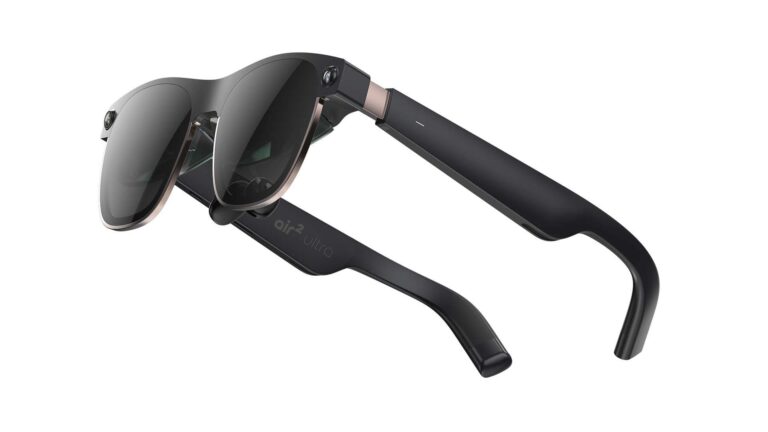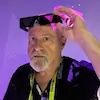
XR came to play at CES this year, but with different vibes than years past. The officially designated XR area of the show floor was not as big as it was last year, but that’s only half the battle. A good portion of the action was still spread out over several venues and invitation-only hotel suites, making it impossible to see everything, even if you walk thirty miles in five days as I did.
A surprising number of companies, including stalwart HTC Vive, were absent, and fewer new players seemed to be arriving on the scene. Consolidation and attrition are culling the herd as funding is flowing to AI ventures. Perhaps the most surprising thing about the XR at CES is how unsurprising it is now. Immersive technologies have gone from being a potentially disruptive new thing to a CES staple.
The biggest star of the XR area, The Apple Vision Pro, wasn’t at CES, nor were Meta, Microsoft, Magic Leap, Rokid, Third Eye, or Lynx. Some of this is surprising, some not. Meta and Microsoft have their own developer conferences. Rokid just raised $70M. Perhaps they were busy doing other things. Pimax and Varjo were there, focused on prosumers and enterprise, where they are primarily used for training and simulation. HTC Vive, whose Elite headset is among the best in PCVR, was absent for the first time in ten years. Company execs Pearly Chen and Alvin Graylin were on panels at Digital Hollywood, but neither would comment on their company’s absence. There were also several companies, like RealWear, that were only doing private demos in hotel suites.
Sony introduced its as-yet-unnamed spatial content creation system, set for a 2024 launch. The headset, which will first be used exclusively by Siemens, looks a bit like the open-sided Quest Pro, but its visor flips up like the HoloLens 2. The system features a 4K OLED XR head-mounted display, a half dozen sensors and cameras, a ring controller, and a pointer, all powered by Qualcomm’s Snapdragon® XR2+ chipset. No word on the price or street date. Sony has a mega-booth at the edge of the Las Vegas Convention Center’s Central Hall. Reviewers lucky enough to be invited into the inner sanctum report the as-yet-unnamed headset a serious competitor to the Vision Pro for enterprise applications.
Xreal’s New Ultra 6 DOF AR HMD meanwhile built momentum during CES. We’ve been following XReal’s story since its founder and CEO, former Magic Leap engineer Chi Xu, boldly announced a $1,000 spatial computing device that took a lot of what was right about the Magic Leap One, and made it better, igniting a nasty lawsuit that only went away when Magic Leap suffered major setbacks, layoffs, reorganization, a new CEO, and renewed focus on enterprise applications. Xreal offloaded batteries and compute onto the smartphone, rather than jamming these hard-to-miniaturize components in the wings of the glasses, greatly reducing the price. The only problem was the Nreal Light and its Nebula spatial computing operating system was kind of janky. So much so that it often failed in company demos. Unsurprisingly, sales were disappointing.
Then Chi did something bold. He seemingly jettisoned spatial computing. Instead, he renamed the company Xreal, and made projector glasses that merely mirrored the screen of the smartphone, which we call assisted, not augmented reality. It is not augmented reality as it does not offer a composite view of the physical and digital, but imagines smart glasses as a mobile phone accessory, not the main event. Xreal sold 300,000 of its Air and Air2 glasses. It saved the company.
But Chi is not giving up on spatial computing. At CES, Xreal introduced the next generation of the Xreal Air 2 smart glasses, the Air2 Ultra (for now). The new device re-introduces spatial computing glasses, but it’s based on the Air2, which keeps the cost down ($699). Tech writers have been going bonkers about it all week. While it is a remarkably low-cost, 6 DOF headset, it’s tethered awkwardly to the smartphone. The company says there is no Bluetooth solution to the power needs of the headset.
As if taking a victory lap, Xreal had a booth that dominated the XR area in the Central Hall at LVCC, and several diverse applications of its headset elsewhere at CES. The Air2 is also being used by Sightful in their monitorless Spacetop laptop, and a new initiative with BMW to imagine the impact of spatial computing on the passenger experience.
My demo of the Xreal Air2 Ultra was flat-out impressive (specs). There are screens and 3D objects all around you, mixed with reality, floating in your room. The 52-degree field of view bests all competitors. It still takes a little getting used to, but screens are anchored in place as they would in the physical world. The glasses weigh in at an impressive 80 grams. The addition of a three-position temple adjustment and extra nose pieces ensure the right fit. The stylish titanium rims ensure that style hides the frame’s slightly too-large look.
We’ll pause there and circle back in part II of this series later in the week with a look at the smart glasses that made a splash at CES…
 Charlie Fink is the author of the AR-enabled books “Metaverse,” (2017) and “Convergence” (2019). In the early 90s, Fink was EVP & COO of VR pioneer Virtual World Entertainment. He teaches at Chapman University in Orange, CA.
Charlie Fink is the author of the AR-enabled books “Metaverse,” (2017) and “Convergence” (2019). In the early 90s, Fink was EVP & COO of VR pioneer Virtual World Entertainment. He teaches at Chapman University in Orange, CA.

